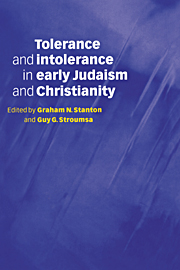Book contents
- Frontmatter
- Contents
- List of contributors
- List of abbreviations
- Introduction
- 1 Intolerance and martyrdom: from Socrates to Rabbi ‘Aqiva
- 2 The other in 1 and 2 Maccabees
- 3 The pursuit of the millennium in early Judaism
- 4 Conservative revolution? The intolerant innovations of Qumran
- 5 Who was considered an apostate in the Jewish Diaspora?
- 6 Why did Paul persecute the church?
- 7 Paul and the limits of tolerance
- 8 Philo's views on paganism
- 9 Coexisting with the enemy: Jews and pagans in the Mishnah
- 10 Tertullian on idolatry and the limits of tolerance
- 11 The threefold Christian anti-Judaism
- 12 The intertextual polemic of the Markan vineyard parable
- 13 Jews and Jewish Christians in the land of Israel at the time of the Bar Kochba war, with special reference to the Apocalypse of Peter
- 14 The Nazoreans: living at the boundary of Judaism and Christianity
- 15 Justin Martyr's Dialogue with Trypho: group boundaries, ‘proselytes’ and ‘God-fearers’
- 16 Accusations of Jewish persecution in early Christian sources, with particular reference to Justin Martyr and the Martyrdom of Polycarp
- 17 Early Christians on synagogue prayer and imprecation
- 18 Messianism, Torah and early Christian tradition
- 19 Jewish and Christian public ethics in the early Roman Empire
- Postscript: the future of intolerance
- General bibliography
- Index
9 - Coexisting with the enemy: Jews and pagans in the Mishnah
Published online by Cambridge University Press: 08 March 2010
- Frontmatter
- Contents
- List of contributors
- List of abbreviations
- Introduction
- 1 Intolerance and martyrdom: from Socrates to Rabbi ‘Aqiva
- 2 The other in 1 and 2 Maccabees
- 3 The pursuit of the millennium in early Judaism
- 4 Conservative revolution? The intolerant innovations of Qumran
- 5 Who was considered an apostate in the Jewish Diaspora?
- 6 Why did Paul persecute the church?
- 7 Paul and the limits of tolerance
- 8 Philo's views on paganism
- 9 Coexisting with the enemy: Jews and pagans in the Mishnah
- 10 Tertullian on idolatry and the limits of tolerance
- 11 The threefold Christian anti-Judaism
- 12 The intertextual polemic of the Markan vineyard parable
- 13 Jews and Jewish Christians in the land of Israel at the time of the Bar Kochba war, with special reference to the Apocalypse of Peter
- 14 The Nazoreans: living at the boundary of Judaism and Christianity
- 15 Justin Martyr's Dialogue with Trypho: group boundaries, ‘proselytes’ and ‘God-fearers’
- 16 Accusations of Jewish persecution in early Christian sources, with particular reference to Justin Martyr and the Martyrdom of Polycarp
- 17 Early Christians on synagogue prayer and imprecation
- 18 Messianism, Torah and early Christian tradition
- 19 Jewish and Christian public ethics in the early Roman Empire
- Postscript: the future of intolerance
- General bibliography
- Index
Summary
This essay aims to analyse some aspects of the rabbinic outlook in the second century, concerning the norms that govern relationships between Jews and pagans. The Mishnah tractate Avodah Zjarah – which is the main source for the following analysis – reflects a reality of two communities, Jewish and pagan, entangled with one another, within the setting of the Hellenistic cities of the land of Israel. The Mishnah's main concern is to create a complex set of norms which will constitute the proper response of Jews towards an environment saturated with pagan worshippers and symbols. The most extreme and telling case of such close proximity between Jews and pagans, which the Mishnah aims to address and regulate, is represented in the Mishnah's ruling concerning a Jewish house which shares a wall with a pagan temple:
If [an Israelite] has a house adjoining an idolatrous shrine and it collapsed, he is forbidden to rebuild it. How should he act? He withdraws a distance of four cubits into his own ground and there builds. [If the wall] belonged both to him and the shrine, it is judged as being half and half …
(Avodah c arah 3.6)The normative question that arises in the Mishnah is: what happens in a case where the wall which is shared by the temple and a neighbouring Jew's house has fallen, and the Jew wants to rebuild the wall? If the Jew re-erects the wall, it will involve not only rebuilding his own house, but also rebuilding a pagan temple. He therefore has to withdraw a distance of four cubits into his own ground.
- Type
- Chapter
- Information
- Tolerance and Intolerance in Early Judaism and Christianity , pp. 159 - 172Publisher: Cambridge University PressPrint publication year: 1998
- 18
- Cited by



